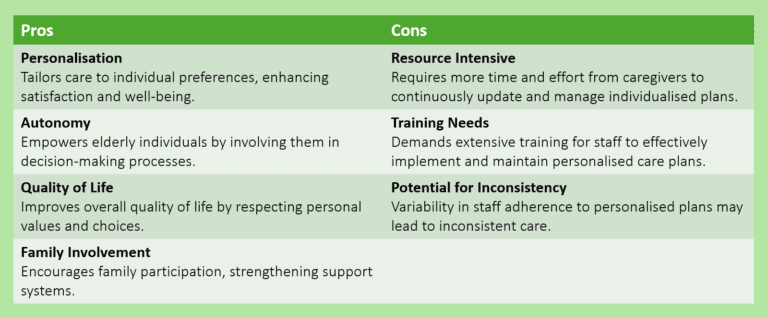Page Contents
As the global population ages, the demand for quality eldercare increases. Central to providing exceptional care is the respect for elderly individuals’ wishes and the preservation of their dignity. This fundamental principle ensures that seniors live their later years with a sense of purpose, autonomy, and respect. When care plans align with the personal values and preferences of the elderly, it not only improves their quality of life but also fosters a compassionate and respectful environment in nursing homes and eldercare facilities.
In this blog article, we will talk about the concept of Preferred Plan of Care which offers a transformative approach to eldercare, one that places the dignity, wishes, and well-being of elderly residents at the forefront. By adopting this model, nursing homes can create environments where each individual feels valued, respected, and empowered.
Existing care plans and models worldwide
Various countries have developed innovative care models that emphasise personalised care and respect for the elderly’s wishes. These models serve as benchmarks for designing effective care strategies.
The Eden Alternative (USA)
Founded by Dr. Bill Thomas, this model focuses on transforming nursing homes into habitats where life revolves around close and continuing contact with plants, animals, and children. It emphasises personal choice and encourages residents to participate in decisions about their daily activities.The Butterfly Model (UK)
Developed by Dementia Care Matters, this approach centers on creating a home-like environment, where the emphasis is on emotional connection and meaningful engagement. Caregivers are trained to see beyond the tasks and focus on the emotional well-being of residents.Buurtzorg (Netherlands)
This model features self-managed teams of nurses who provide holistic care, ensuring that the elderly can remain in their homes as long as possible. It emphasises building strong relationships between caregivers and clients, promoting autonomy and personalised care.Green House Project (USA)
This model transforms traditional nursing homes into small, community-based residences that provide individualised care in a home-like setting. Residents have private rooms and bathrooms and participate in household activities, fostering a sense of community and purpose.
Introduction to the concept of Preferred Plan of Care
The Preferred Plan of Care is an approach that seeks to integrate the best practices of these models while prioritising the explicit wishes and preferences of the elderly. This model involves creating a detailed and individualised care plan that is continuously updated based on regular discussions with the elderly and their families.

Pros and cons of the Preferred Plan of Care
Implementing the Preferred Plan of Care offers numerous benefits, but it also presents certain challenges. Understanding both the advantages and potential drawbacks is crucial for nursing homes considering this model. By weighing these pros and cons, facilities can make informed decisions about how best to integrate personalised care plans that honour the wishes and dignity of their elderly residents.

Is it the same as Advance Care Planning?
The Preferred Plan of Care and Advance Care Planning are both integral to providing personalised and respectful eldercare, but they focus on different aspects of care.
The Preferred Plan of Care is a comprehensive approach that involves creating and continuously updating individualised care plans based on the ongoing preferences and needs of residents. It emphasises day-to-day choices and personal autonomy, ensuring that the care provided aligns with residents’ current wishes and values.
In contrast, Advance Care Planning primarily focuses on preparing for future medical decisions, often when residents may no longer be able to communicate their preferences. It involves documenting residents’ wishes regarding life-sustaining treatments, resuscitation, and other critical healthcare decisions.
While both models prioritise respect for the individual’s wishes, the Preferred Plan of Care offers a more proactive, holistic and dynamic approach, encompassing daily living preferences alongside medical care, whereas Advance Care Planning is specifically geared towards end-of-life decision-making and scenarios where residents might lose decisional capacity. Integrating both approaches can ensure comprehensive, respectful, and personalised care for elderly residents.
Why nursing homes should adopt the Preferred Plan of Care
Adopting the Preferred Plan of Care can transform nursing homes into environments where elderly individuals feel valued and respected. This model not only meets the physical needs of residents but also addresses their emotional and psychological well-being.
By prioritising personal preferences, nursing homes can enhance resident satisfaction, reduce instances of depression and anxiety, and foster a more positive atmosphere. Moreover, it aligns with ethical standards and legal requirements to respect the rights and dignity of elderly individuals.
Resident’s choices versus next-of-kin’s preferences
A critical aspect of implementing the Preferred Plan of Care involves navigating the delicate balance between the choices of the elderly residents and the preferences of their next-of-kin (NOK). While the primary focus should always be on respecting the wishes and autonomy of the residents, there are instances where the NOK’s input becomes vital, especially when residents may have cognitive impairments (e.g. dementia) or difficulties in communicating their desires.
Ideally, the residents’ choices should take precedence, as they are the ones directly experiencing the care and its impacts. Autonomy in eldercare underscores the importance of enabling residents to make decisions about their own lives to the fullest extent possible. However, the NOK can play a crucial role in advocating for the best interests of their loved ones, especially when the residents’ ability to make informed decisions is compromised. In such cases, it is essential to engage in collaborative discussions that honour the resident’s known preferences and values, while also considering the NOK’s insights. Ultimately, the goal is to create a care plan that best supports the resident’s well-being, ensuring their voice remains central in the decision-making process.
Steps for implementing the care plan

- Know the residents
Begin with comprehensive assessments of each resident’s preferences, needs, and values. Document these in a detailed care plan. - Train & prepare the care staff
Provide extensive training to caregivers on the principles of personalised care and the importance of respecting residents’ wishes. - Develop & review the care plan
Schedule regular meetings with residents and their families to review and update care plans. - Communication & updates
Ensure clear communication channels between staff, residents, and families to facilitate the continuous sharing of information and feedback. Utilise digital tools to manage and update care plans efficiently, ensuring everyone has real-time access to the latest information. - Create a supportive environment
Foster a culture that values and respects the individuality of each resident, encouraging staff to build meaningful relationships with residents.
Conclusion
The Preferred Plan of Care represents a shift towards more personalised, dignified, and respectful eldercare. By adopting this model, nursing homes can ensure that residents’ voices are heard, their preferences respected, and their dignity upheld. It is an investment in the well-being and happiness of the elderly, creating environments where they can thrive and live their later years with joy and purpose. The eldercare sector is encouraged to explore and implement this concept, paving the way for a future where every elderly individual receives care that truly honors their wishes and dignity.
